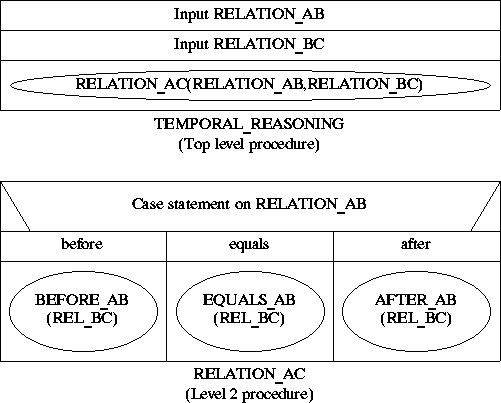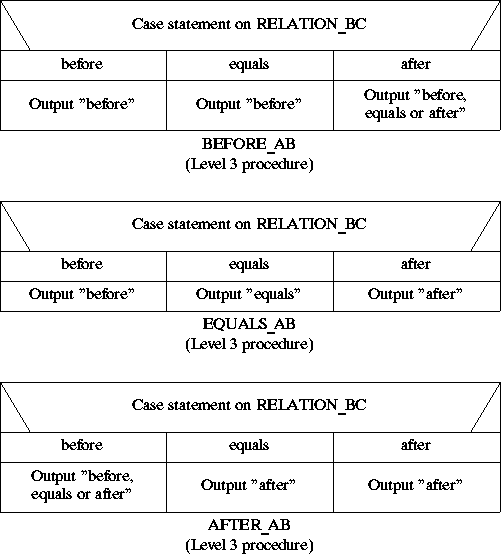
An enumerated type is a user defined discrete scaler type where the possible values for the type are itemised. Ada example declaration:
type DAYS is (MONDAY, TUESDAY, WEDNESDAY,
THURSDAY, FRIDAY, SATURDAY, SUNDAY);
NEWDAY: DAYS := WEDNESDAY;
Here we have created an "enumerated" type DAYS and an instance, NEWDAY of that type. Note
that the values in a enumerated type are "ordered" so that
the value listed first is least and the value listed last is greatest. Conceptually at
least, each value for an enumeration also has an ordinal value.
This allows comparison of enumerated type values using operators such as < (less than) and > (greater than).
Ada provides a number of attributes for enumerations:
| First | Gives first value of the enumeration |
|---|---|
| Last | Gives last value of the enumeration |
| pred(X) | Gives the predecessor of the enumerated value X |
| succ(X) | Gives the successor of the enumerated value X |
Note that the value used in conjunction with the pred and succ attributes must not be the first or last values respectively. Example of the application of enumeration attributes:
with TEXT_IO ;
use TEXT_IO ;
procedure ENUMERATION_ATTRIBUTES is
type DAYS is (MONDAY, TUESDAY, WEDNESDAY,
THURSDAY, FRIDAY, SATURDAY, SUNDAY);
package DAYS_INOUT is new ENUMERATION_IO(DAYS);
use DAYS_INOUT;
NEWDAY: DAYS;
begin
PUT("DAYS'FIRST:= ");
PUT(DAYS'FIRST);
NEW_LINE;
PUT("DAYS'LAST:= ");
PUT(DAYS'LAST);
NEW_LINE;
GET(NEWDAY);
PUT("NEWDAY:= ");
PUT(NEWDAY);
NEW_LINE;
PUT("DAYS'PRED(NEWDAY):= ");
PUT(DAYS'PRED(NEWDAY));
NEW_LINE;
PUT("DAYS'SUCC(NEWDAY):= ");
PUT(DAYS'SUCC(NEWDAY));
NEW_LINE;
if (NEWDAY < THURSDAY) then
PUT("if NEWDAY < THURSDAY, NEWDAY:= ");
PUT("MONDAY, TUESDAY or WEDNESDAY");
NEW_LINE;
end if;
end ENUMERATION_ATTRIBUTES;
Note how input/output for the enumerated type has been achieved in the above example.
In an earlier example progarm a simple calculator applicvation was produced. This allowed users to input a simple arithmetic expression of the form:
Where <OPERAND> is an integer of some kind and <OPERATOR> is one of the operators `+', `-', `*' or `/'. The top level procedure for the implementation commenced as follows:
procedure CALCULATOR is
subtype OPERAND_T is INTEGER range -14654..14654;
package INTEGER_INOUT is new INTEGER_IO(INTEGER);
use INTEGER_INOUT;
OPERAND_1, OPERAND_2 : OPERAND_T;
OPERATOR : CHARACTER;
and so on. An alternative to the above might be:
procedure CALCULATOR is
type OPERATOR_T is ('+', '-', '*', '/');
subtype OPERAND_T is INTEGER range -14654..14654;
package OPERATOR_INOUT is new ENUMERATION_IO(OPERAND_T);
use OPERATOR_INOUT;
package INTEGER_INOUT is new INTEGER_IO(INTEGER);
use INTEGER_INOUT;
OPERAND_1, OPERAND_2 : OPERAND_T;
OPERATOR : OPERATOR_T;
Here we have defined the data item OPERATOR as being of type OPERATOR_T which in turn is defined as an enumerated type. This alternative implementation offers the advantage that values for the OPERATOR data item are checked automatically.
A well known enumerated types (although not often recognised as such) is the Boolean type. In Ada this would be specified as follows:
type BOOLEAN is (FALSE, TRUE);
It is also possible to consider any discrete type (e.g. integer, character) to be an enumerated type.
Develop a temporal reasoning system which when given (1) the temporal relationship that exists between tow points A and B and (2) the temporal relationship that exists between the point B and a further point C, determines the temporal relationship that exists between the points A and C.
Note that there are only three temporal relations that can exist between any two points located along a time line: "before", "equals" and "after". Thus there are three relations that can link the points A and B, and three relations that can link the points B and C.
To determine the relation between A and C we can use a technique known as a transitivity table. This comprises a table with the possible relations between A and B represented by the horizontal axis, and the possible relations between B and C represented by the vertical axis. At the intersections are given the relations that must exist between A and C given particular coordinate relations. Thus:
| Relation between A and B | |||
|---|---|---|---|
| Relation between B and C | Before | Equals | After |
| Before | Before | Before | Before, Equals or After |
| Equals | Before | Equals | After |
| After | Before, Equals or After | After | After |
A top-down analysis of the proposed problem is given below.

We will implement this using four procedures/functions:
| NAME | USAGE | TYPE | RANGE |
|---|---|---|---|
| RELATION_AB | Input variable | RELATION (Enumerated type) | BEFORE, EQUALS, AFTER |
| RELATION_BC | Input variable | RELATION (Enumerated type) | BEFORE, EQUALS, AFTER |
| NAME | USAGE | TYPE | RANGE |
|---|---|---|---|
| REL_AB | Formal parameter | RELATION (Enumerated type) | BEFORE, EQUALS, AFTER |
| REL_BC | Formal parameter | RELATION (Enumerated type) | BEFORE, EQUALS, AFTER |
| NAME | USAGE | TYPE | RANGE |
|---|---|---|---|
| REL_BC | Formal parameter | RELATION (Enumerated type) | BEFORE, EQUALS, AFTER |
| NAME | USAGE | TYPE | RANGE |
|---|---|---|---|
| REL_BC | Formal parameter | RELATION (Enumerated type) | BEFORE, EQUALS, AFTER |
| NAME | USAGE | TYPE | RANGE |
|---|---|---|---|
| REL_BC | Formal parameter | RELATION (Enumerated type) | BEFORE, EQUALS, AFTER |
Complete Nassi-Schneiderman charts for the above are given below:


A Data Flow Diagram indicating the broad flow of control through the above is given below.

-- TEMPORAL REASONING
-- 1 October 1997
-- Frans Coenen
-- Dept Computer Science, University of Liverpool
with TEXT_IO;
use TEXT_IO;
procedure TEMPORAL_REASONING is
type RELATION is (before, equals, after);
package RELATION_INOUT is new ENUMERATION_IO(RELATION);
use RELATION_INOUT;
RELATION_AB, RELATION_BC : RELATION;
-----------------------------------------------------------------------
-- Identify horizontal element in transitivity table
procedure RELATION_AC(REL_AB, REL_BC : RELATION) is
-------------------------------------------------------------------
-- BEFORE AB
procedure BEFORE_AB(REL_BC : RELATION) is
begin
case REL_BC is
when before | equals =>
PUT_LINE("A before C");
when after =>
PUT_LINE("A before, equals or after C");
end case;
end BEFORE_AB;
-------------------------------------------------------------------
-- EQUALS AB
procedure EQUALS_AB(REL_BC : RELATION) is
begin
case REL_BC is
when before =>
PUT_LINE("A before C");
when equals =>
PUT_LINE("A equals C");
when after =>
PUT_LINE("A after C");
end case;
end EQUALS_AB;
-------------------------------------------------------------------
-- AFTER AB
procedure AFTER_AB(REL_BC : RELATION) is
begin
case REL_BC is
when before =>
PUT_LINE("A before, equals or after C");
when others =>
PUT_LINE("A after C");
end case;
end AFTER_AB;
-------------------------------------------------------------------
begin
case RELATION_AB is
when before =>
BEFORE_AB(REL_BC);
when equals =>
EQUALS_AB(REL_BC);
when after =>
AFTER_AB(REL_BC);
end case;
end RELATION_AC;
-----------------------------------------------------------------------
begin
-- Input data
PUT_LINE("Input relation A and B (before, equals or after)");
GET(RELATION_AB);
PUT_LINE("Input relation B and C (before, equals or after)");
GET(RELATION_BC);
-- Determine relation linking points A and C
RELATION_AC(RELATION_AB,RELATION_BC);
NEW_LINE;
end TEMPORAL_REASONING;
| TEST CASE | EXPECTED RESULT | |
|---|---|---|
| RELATION_AB | RELATION_BC | OUTPUT |
| before | before | before |
| before | equals | before |
| before | after | before, equals or after |
| equals | before | before |
| equals | equals | equals |
| equals | after | after |
| after | before | before, equals or after |
| after | equals | after |
| after | after | after |
| between | * | DATA_ERROR |
| before | between | DATA_ERROR |
The simplest way to test the above code is to test every combination of input. There are only nine of these as shown in the table to then right. We should also test an input for each relation which is not included in the enumeration. These tests will ensure that all paths through the system are followed.
Example Problem Temporal Reasoning.
Created and maintained by Frans Coenen. Last updated 11 October 1999